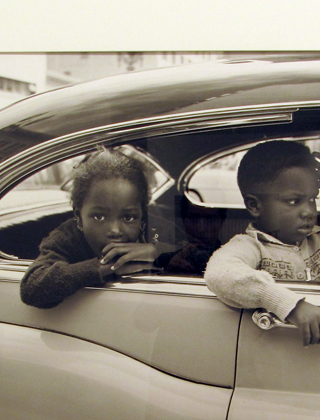A three days dip between Nuoro and Alghero to chase the first exhibition landed in Italy dedicated to the works of the photographer Vivian Maier. An interesting personal and professional story, and a very original one: nanny between New York and Chicago, she soon is interested in photography, and with the help of the inheritance of a relative she armed herself with good tools. And so, when she went out with her children, she began to snapshot every corner of the city and every person that catched her attention, using a special eye for the situation and for the shots. She took pictures to fill 200 boxes of rolls and negative. Never developed. Only carried with her throughout her life. I discovered her time ago, watching the the film documentary not only about her history, but on the particular finding of her treasure and how her masterpieces has finally seen the light.
I absolutely recommend the movie, called “Finding Vivian Maier.”
So, after having appreciated her work on screen, once I knew that would be on display in Italy, I could not help but go, too, to her finding. A location not too handy for me, but I must say that with a low cost from Bologna it is absolutely feasible, and Sardinia at this time is much more relaxing than during the summer. They were three days of warm autumn, clear skies and calm seas. Few tourists, mostly foreigners, and shops and restaurants still open.
The exhibition was a great success: will end in a few days and I could not find the poster, or book, or DVD…all sold out…but I am very happy it had this finding. Nuoro (venue of the exhibition, at MAN museum), birthplace of Grazia Deledda, impressed me very much, unlike my expectations. Houses and streets remind a seaside town, but it’s set among high hills, overlooking the Supramonte. Baroque and neoclassical facades faded and crumbling from the sea, doors and decorated iron balconies, cobbled streets and squares and gardens of palms.
Being able to see these two cities was the other spark that made me decide to return to Sardinia. And then the desire to savor those views: soft expanses dotted with goats and cows, olive and cork trees, low walls and nuragic villages. The island’s history is ancient, it begins from the Neolithic and runs thousands of years, leaving the territory finds and settlements. Maybe it’s for its history or its landscapes or its food always special, made of strong flavors of earth that blend with those of the sea: the fact is that as the other times when I met her, this land still haunted me.
Alghero instead, facing the sea, has given us light and unique colors.
It has a small and twisted old town and had Saracen and Catalan influences, which you can clearly see in the architecture (from the ramparts to the fortified sea towers) and feel in the spoken language: good part of the community still speaks a dialect of Catalan. Rich in churches, among which I particularly liked the Cathedral of Santa Maria, Alghero is also a city with a long history that deserves a thorough visit.
Outside Alghero: natural park, a lagoon, the promontory of Capo Caccia with the cave of Neptune and archaeological sites. From the nuragic village of Palmavera to the Roman ruins and Neolithic tombs (or domus de Janas) of Angelu Ruju.
We hired an electric car and in a day we took the full tour. We went down to see the caves from the Escala del Cabirol: about 650 concrete steps running along impressive cliffs overlooking the sea. From the viewpoint of Capo Caccia I captured the small island Foradada and had lunch at the New Tower of Porto Conte, with its cat colony. But we must go back and see more, more calmly.









































